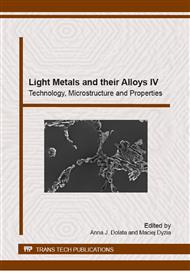[1]
J. Adamiec, The assessment of impact of construction factors on weldability of MSRB alloy, Materials Science Forum 690 (2011) 37-40.
DOI: 10.4028/www.scientific.net/msf.690.37
Google Scholar
[2]
A. Kiełbus, T. Rzychoń, The intermetallic phases in sand casting magnesium alloys for elevated temperature, Materials Science Forum 690 (2011) 214-217.
DOI: 10.4028/www.scientific.net/msf.690.214
Google Scholar
[3]
K. Meshinchi Asl, A. Tari, F. Khomamizadeh, The effect of different content of Al, RE and Si element on the microstructure, mechanical and creep properties of Mg–Al alloys, Materials Science and Engineering A 523 (2009) 1-6.
DOI: 10.1016/j.msea.2009.06.048
Google Scholar
[4]
A. Kiełbus, Microstructure and properties of sand casting magnesium alloys for elevated temperature applications, Solid State Phenomena, 176 (2011) 63-74.
DOI: 10.4028/www.scientific.net/ssp.176.63
Google Scholar
[5]
A. Luo, M. O. Pekguleryuz, Cast magnesium alloys for elevated temperature applications, Journal of Materials Science 29 (29) 5259-5271.
DOI: 10.1007/bf01171534
Google Scholar
[6]
W. Pachla, A. Mazur, J. Skiba, M. Kulczyk, S. Przybysz, Wrought magnesium alloys ZM21, ZW3 and WE43 processed by hydrostatic extrusion with back pressure, Archives of Metallurgy and Materials 57 (2012) 485-493.
DOI: 10.2478/v10172-012-0050-3
Google Scholar
[7]
W. Wang, G. Wu, M. Sun, Y. Huang, Q. Wang, W. Ding, Effect of flux containing YCl3 on the yttrium loss, mechanical and corrosion properties of Mg-10Gd-3Y-0. 5Zr alloy, Materials Science and Engineering A 527 (2010) 1510-1515.
DOI: 10.1016/j.msea.2009.10.023
Google Scholar
[8]
J. Wang, J. Zhou, W. Tong, Y. Yang, Effect of purification treatment on properties of Mg-Gd-Y-Zr alloy, Trans. Nonferrous Met. Soc. China 20 (2010) 1235-1239.
DOI: 10.1016/s1003-6326(09)60284-3
Google Scholar
[9]
B. Dybowski, R. Jarosz, A. Kiełbus, J. Cwajna, Influence of pouring temperature on castability and microstructure of QE22 and RZ5 magnesium casting alloys, Solid State Phenomena 191 (2012) 137-144.
DOI: 10.4028/www.scientific.net/ssp.191.137
Google Scholar
[10]
B. Dybowski, A. Kiełbus, R. Jarosz, R. Jarosz, The Microstructure of Elektron21 and WE43 Magnesium Casting Alloys after Subsequent Melting Process Operations, Solid State Phenomena 211 (2014) 65-70.
DOI: 10.4028/www.scientific.net/ssp.211.65
Google Scholar
[11]
A. Rakowska, U, M. Podosek, R. Ciach, Some aspects of solidification and homogenisation of Mg–Ag alloys, Materials and Design 18 (1997) 279-283.
DOI: 10.1016/s0261-3069(97)00064-2
Google Scholar


